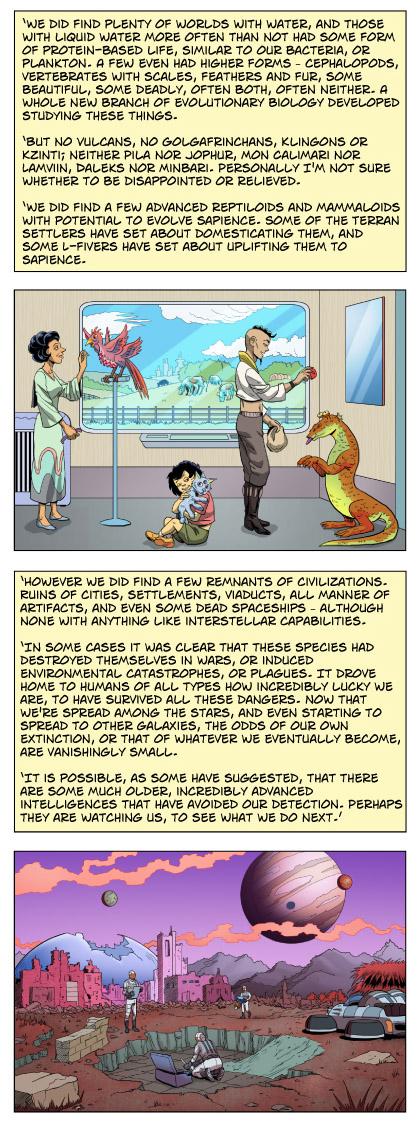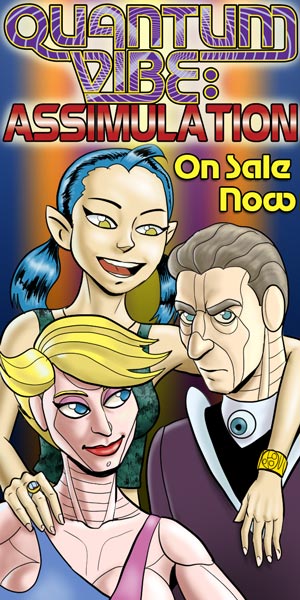Strip 1094 - Click strip above to goto the next strip.
First Seen: Thu 2015-05-14
Story & Art: Scott Bieser - Colors: Lea Jean Badelles
Sci-Fi Adventure Monday & Thursday.
Quantum Vibe
A thousand years in the future, humanity has colonized worlds in nearly 100 galaxies, thanks to Quantum Vibremonic technologies developed five centuries earlier. Other new technologies have created various off-shoots of humanity and extended life expectancies five-fold. The story begins with how a mad scientist and his plucky assistant, along with their robot friend, brought humanity to the stars, and continues with the adventures of some unique people in fantastic places.
One Dollar Sale Continues! [ Jun 24, 2025 ]

Hard to believe it, but Big Head Press published it's first novel, over 20 years ago. To commemorate our stubborn longevity, we continue to stubbornly offer each of our non serialized graphic novel stories for just one mere American dollar (plus shipping). Start your holiday shopping early and light up some body's mind with one or more of these titles.
Offer only available in the United States.
Transcript For Strip 1094
Panel 1Text panel
Caption: 'But what we were more surprised NOT to find, were alien civilizations.
We did find plenty of worlds with water, and those with liquid water more often than not had some form of protein-based life, similar to our bacteria, or plankton. A few even had higher forms – cephalopods, vertebrates with scales, feathers and fur, some beautiful, some deadly, often both, often neither. A whole new branch of evolutionary biology developed studying these things.
But no Vulcans, no Golgafrinchans, Klingons or Kzinti; neither Pila nor Jophur, Mon Calimari nor Lamviin, Daleks nor Minbari. Personally I'm not sure whether to be disappointed or relieved.
We did find a few advanced reptiloids and mammaloids with potential to evolve sapience. Some of the Terran settlers have set about domesticating them, and some others have set about 'uplifting' them to sapience.
Panel 2
A family of humans in a menagerie of alien critters. A four-winged avian perches on a stand; a little girl cuddles with a six-legged quasi-kitten; a man is training a lizardog.
No dialog
Panel 3
Text panel
Caption: However we did find a few remnants of civilizations. Ruins of cities, settlements, viaducts, all manner of artifacts, and even some dead spaceships – although none with anything like interstellar capabilities.
In some cases it was clear that these species had destroyed themselves in wars, or induced environmental catastrophes, or plagues. It drove home to humans of all types how incredibly lucky we are, to have survived all these dangers. Now that we're spread among the stars, and even starting to spread to other galaxies, the odds of our own extinction, or that of whatever we eventually become, are vanishingly small.
It is possible, as some have suggested, that there are some much older, incredibly advanced intelligences that have avoided our detection. Perhaps they are watching us, to see what we do next.
Panel 4
Some archeologists exploring ruins of an alien city under a clearly alien sky.
No dialog
Web-comics Scott Reads
SPACETRAWLERGrrl Power
Schlock Mercenary
Unsounded
Diesel Sweeties
Girl Genius
XKCD
Drive
Day By Day
Saturday Morning Breakfast Cereal
Questionable Content
Gunnerkrigg Court
Something * Positive
Oglaf (NSFW)
Trekker
HELM
POWERNAP
For news and reviews:
The Beat
Bleeding Cool
Comics Worth Reading
Framing Graphics © 2024 Big Head Press


















